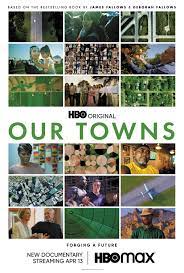
OUR TOWNS
US, 2021, 97 minutes, Colour.
Directed by Steven Ascher, Jeanne Jordan.
Our Town was a very popular play by Thornton Wilder, frequently performed, filmed, in the 1930s and 1940s. It was a focus on life in a small American town.
Renowned international journalists, James Fallows, his wife Deborah Fallows, spent many decades in Asia, reporting from China and Japan, travelling widely. In the 2000s, they returned to the United States, beginning this project, Our Towns, in the wake of the financial crisis, 2008-2009, and completing this film during the first year of Covid.
The room was directed by Steven Ascher, Jeanne Jordan, Oscar nominees for documentaries.
One of the most important aspects of this film and its survey of the United States over a decade is that it explicitly excludes focusing on the partisanship, the increasingly divided United States, especially during the presidency of Donald Trump. Rather, this is a very positive look at Americans, at Americans working together, at the building up of community and our towns.
The film was based on a series of articles and book by the Fallows. For the film, they have selected six towns, wide ranging over the United States. They have a small plane which enables them to land in more remote towns and cities. The two featured during the film, usually in conversation with people from the towns, a very genial and thoughtful couple, asking questions, very affirming in their questions and responses. They also offer their own reflections, especially at the end, in view of the range of visits.
The six towns visited are Redlands, California, part of the Inland Empire, the desert towns outside Los Angeles, where James Fallows grew up. There is also a focus on the nearby San Bernardino, declining, declared bankrupt, beginning to build up. With the growth in technology and many people wanting to live outside the big cities, the Inland Empire is having a revival. After that, there is a visit to Sioux Falls, South Dakota, memories of the Sioux nation, seeing how they have survived, but also focusing on banks and other institutions settling in South Dakota, and with industries, a reliance on the great range of migrants from so many countries.
Then there is a visit to what can be considered the poorest state, Mississippi, a visit to the city of Columbus, again a city in decline, but cultural developments, some industries, and people willing to move there. It is something the same with East Port, Maine, a harbour, a city with a hugely diminished population, changes in the fishing industry, but, again, improvements in the industry, salmon farms, people moving out of the cities, and the strongly developed cultural life.
It is something the same in the final two cities, ranging from Charlestown, West Virginia, the city in decline, the decline in mining and the coal industry, and the attempts to bring different activities to the town – especially an extraordinarily vast mural, painted on a large street wall, dramatising the life and vitality of West Virginia. The final stop is Bend, Oregon, the death of the timber industry, and, once again, people moving to the different landscapes and a city reviving, with large suburbs and an influx of people, almost becoming too large.
As a hopeful film, even an optimistic film, avoiding the political divisions of the 21st-century and focusing on American people, everyone except Native Americans being immigrants, importing immigrants to sustain new work, new industry, the developments of technology, a greater sense of community, cultural creativity.